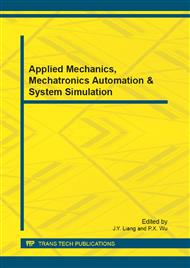[1]
Y. Moisiadis, et al, A CMOS charge pump for low voltage operation, Proc., IEEE International Symposium on Circuits and Systems, pp.577-580, (2000).
DOI: 10.1109/iscas.2000.857500
Google Scholar
[2]
A. Richelli, et al, A 1. 2V-5V high efficiency CMOS charge pump for non-volatile memories, IEEE International Symposium on Circuits and Systems, pp.2411-2414, (2007).
DOI: 10.1109/iscas.2007.377946
Google Scholar
[3]
J.T. Wu, K. L. Chang, MOS charge pumps for low voltage operation, IEEE J. on Solid-State Circuits, pp.592-597, Apr. (1998).
DOI: 10.1109/4.663564
Google Scholar
[4]
R. Pelliconi, et al, Power efficient charge pump in deep submicron standard CMOS technology, Proc., 27th European Solid-State Circuits Conference, pp.73-76, (2001).
DOI: 10.1109/jssc.2003.811991
Google Scholar
[5]
C. C. Wang, et al Efficiency improvement in charge pump circuits, IEEE J. Solid-State Circuits, vol. 32, pp.852-860, Apr. (1998).
DOI: 10.1109/4.585287
Google Scholar
[6]
A. Cabrini, L. Gobbi and G. Torelli, Enhanced charge pump for ultra-low-voltage applications, Electronics Letters, vol. 42, no. 9, pp.512-514, (2006).
DOI: 10.1049/el:20060565
Google Scholar
[7]
C. Cruz, C. Filho, J. Lima, A charge pump without overstress for standard cmos process with improved current driver capability, IEEE 25 th Convention of Electrical and Electronics Engineers in Israel, pp.618-622, (2008).
DOI: 10.1109/eeei.2008.4736606
Google Scholar
[8]
G. van Steenwijk, K. Hoen, H. Wallinga, Analysis and design of a charge pump circuit for high output current applications, Nineteenth European Solid-State Circuits Conference, vol. 1, pp.118-121, (1993).
Google Scholar
[9]
P. Jun and T. Yoshihara, A charge pump circuit without overstress in low-voltage CMOS standard process, IEEE Conference on Electron Devices and Solid-State Circuits, pp.501-504, (2007).
DOI: 10.1109/edssc.2007.4450172
Google Scholar
[10]
N. Li, et al High efficiency four-phase all PMOS charge pump without body effects, International Conference on Communications, Circuits and Systems, pp.1083-1087, (2008).
DOI: 10.1109/icccas.2008.4657956
Google Scholar
[11]
Raben, H., Borg, J., Johansson, J., Improved efficiency in the CMOS cross-connected bridge rectifier for RFID applications, Mixed Design of Integrated Circuits and Systems (MIXDES), 2011 Proceedings of the 18th International Conference, On page(s): 334 - 339, Volume: Issue: , 16-18 June (2011).
DOI: 10.1109/mixdes.2016.7529757
Google Scholar
[12]
R. R. Troutman, Latch-up in CMOS Technology, 1986 : Kluwer.
Google Scholar
[13]
G. Hu, A better understanding of CMOS latchup, IEEE Trans. Electron Devices, vol. ED-31, p.62 (1984).
Google Scholar
[14]
R. K. Gupta, I. Sakai, and C. Hu, Effects of substrate resistance on CMOS latchup holding voltages, IEEE Trans. Electron Devices, vol. ED-34, pp.2309-2316 (1987).
DOI: 10.1109/t-ed.1987.23237
Google Scholar
[15]
R. Menozzi, et al., Layout dependence of CMOS latch-up, IEEE Trans. Electron Devices, vol. 35, pp.1892-1901 (1988).
DOI: 10.1109/16.7402
Google Scholar
[16]
Y. -H. Yang and C. -Y. Wu, A new criterion for transient latchup analysis in bulk CMOS, IEEE Trans. Electron Devices, vol. 36, pp.1336-1347 (1989).
DOI: 10.1109/16.30939
Google Scholar
[17]
T. Furuyama, et al., A latch-up-like new failure mechanism for high-density CMOS dynamic RAM's, IEEE J. Solid-State Circuits, vol. 25, pp.42-47 (1990).
DOI: 10.1109/4.50282
Google Scholar
[18]
D. B. Estreich, The physics and modeling of latch-up and CMOS integrated circuits, 1980 Kontos, D., Gauthier, R., Chatty, K., Domanskr, K., Muhammad, M., Seguin, C., Halbach, R., External Latchup Characteristics Under Static and Transient Conditions in Advanced Bulk CMOS Technologies, Reliability physics symposium, 2007. proceedings. 45th annual. ieee international, On page(s): 358 - 363, Volume: Issue: , 15-19 April (2007).
DOI: 10.1109/relphy.2007.369915
Google Scholar
[19]
M. Hargrove, S. Voldman, R. Gauthier, 1. Brown, K. Duncan, and W. Craig, Latchup in CMOS technology, , in Proc. IEEE Int. Reliab . Phys. Symp., 1998. pp.269-78.
DOI: 10.1109/relphy.1998.670561
Google Scholar
[20]
M. -D. Ker and S. -F. Hsu, Physical mechanism and device simulation on transient-induced latchup in CMOS ICs under system-level ESD test, , IEEE Trans. Electron Devices, vol. 52, no. 8, pp.1821-1831, (2005).
DOI: 10.1109/ted.2005.852728
Google Scholar


